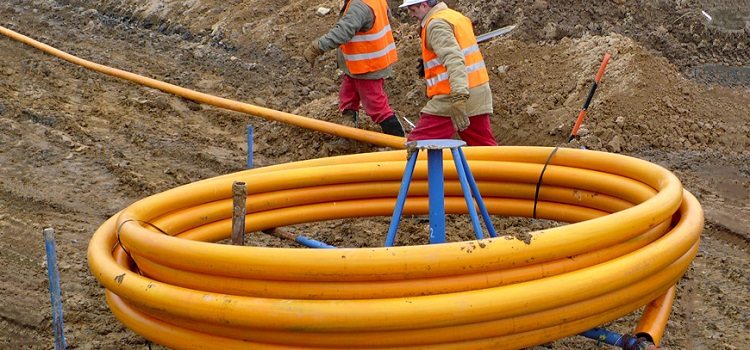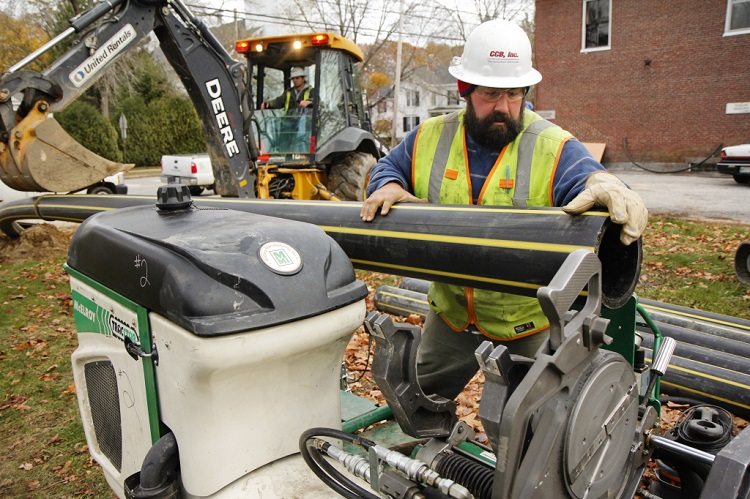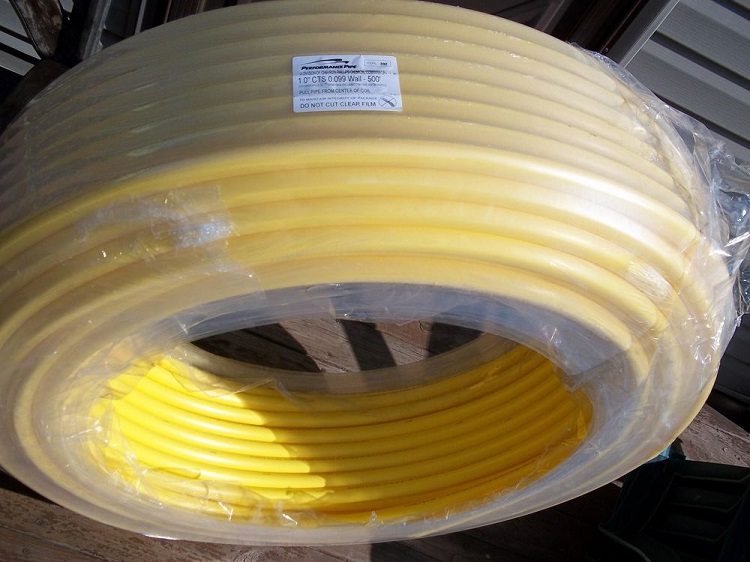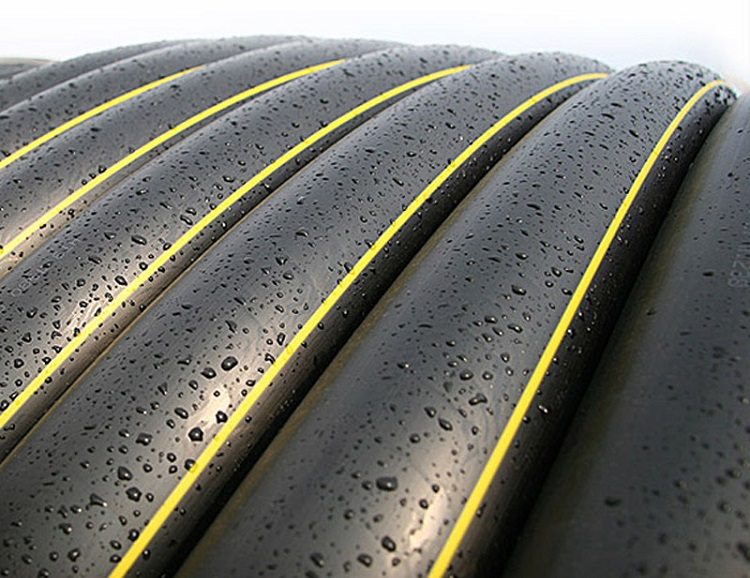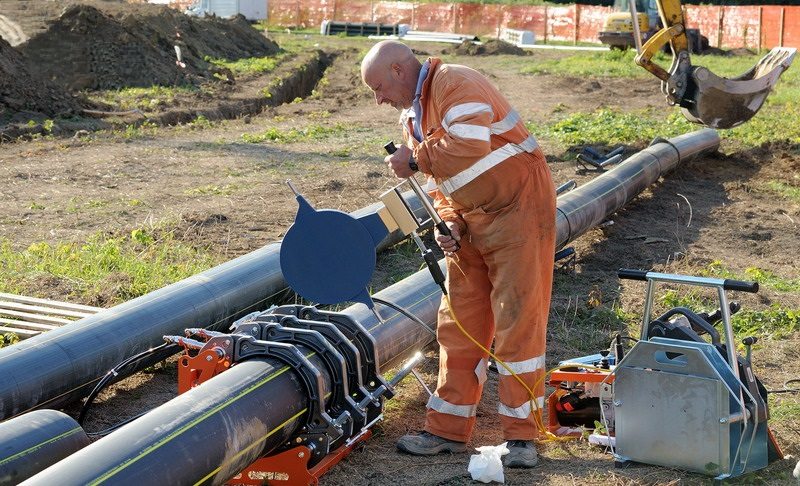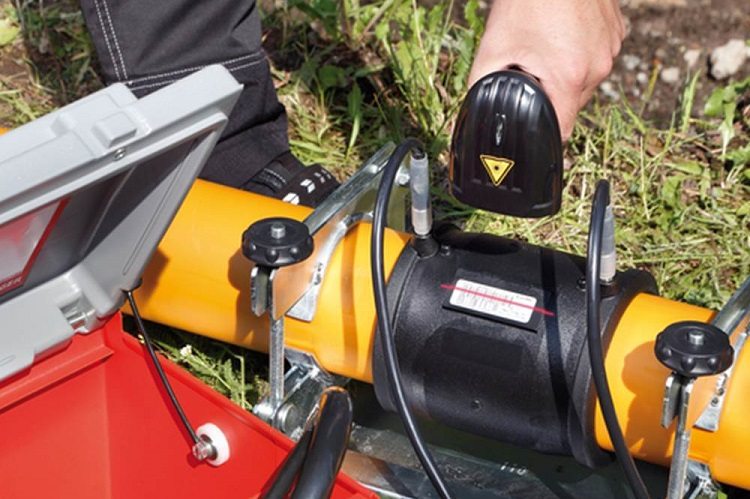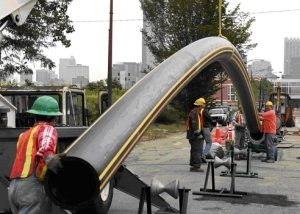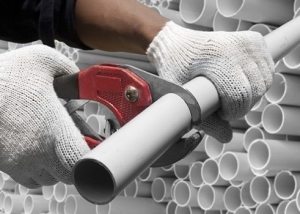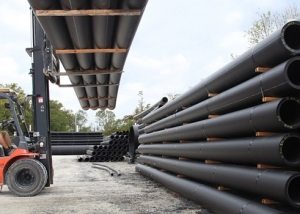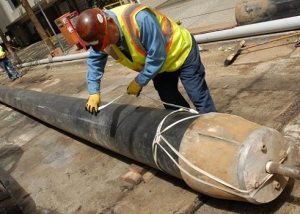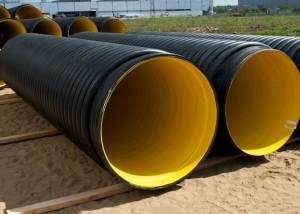The characteristics of polyethylene allow it to be used in external and internal sewerage systems, hot and cold (including drinking) water supply, for the installation of underfloor heating and the installation of heating mains, etc. The gas pipeline can be laid not only with the use of steel products, but also HDPE gas pipes. Air-gas mixtures and gases not containing aromatic hydrocarbons are transported through such channels.
Content
Characteristics of HDPE pipes for gas
Polyethylene pipes for gas are high-quality products characterized by:
- low fluidity: 15-30 MPa;
- low thermal conductivity;
- high throughput: 30% more than steel pipes;
- great flexibility: up to 7% of the initial parameters;
- elasticity.
Pipes for gas pipelines pass a special specification. Their transportation can be carried out at a temperature exceeding -10 ° C. Storage of PND products can be carried out in rooms without heating or under a canopy on the street for a period of not more than 2 years.
Characteristics of polyethylene products for the gas pipeline are given in tables 1, 2 and 3.
Table 1
| PE 80 SDR17.6 / PE 80 SDR11 (pressure 6 atm.) | |||
| Diameter in mm | Weight of one meter, kg | Wall thickness in mm | Standard length, m |
| 32 | -/0,277 | -/3,0 | 200 |
| 40 | -/0,427 | -/3,7 | |
| 63 | 0,682/1,05 | 3,6/5,8 | |
| 90 | 1,4/2,12 | 5,2/8,2 | 200(12)/200(13) |
| 110 | 2,0/3,14 | 6,3/10 | |
| 125 | 2,66/4,08 | 7,1/11,4 | 12/13 |
| 160 | 4,35/6,67 | 9,1/14,6 | |
| 225 | 8,55/13,2 | 12,8/20,5 | |
| 315 | 16,7/25,7 | 17,9/28,6 | |
| 400 | 26,9/41,4 | 22,7/36,3 | |
| 500 | 42,0/64,7 | 28,3/45,4 | |
| 630 | 66,6/103 | 35,7/57,2 | |
table 2
| PE 100 SDR17.6 (pressure 3 atm.) / PE 100 SDR11 (pressure 10 atm.) | |||
| Diameter in mm | Weight of one meter, kg | Wall thickness in mm | Standard length, m |
| 32 | -/0,277 | -/3,0 | 200 |
| 63 | 0,682/1,05 | 3,6/5,8 | |
| 90 | 1,4/2,12 | 5,2/8,2 | 200(12)/200(13) |
| 110 | 2,07/3,14 | 6,3/10 | |
| 160 | 4,35/6,67 | 9,1/14,6 | 12/13 |
| 225 | 8,55/13,2 | 12,8/20,5 | |
| 315 | 16,7/25,7 | 17,9/28,6 | |
| 400 | 26,9/41,4 | 22,7/36,3 | |
| 500 | 42,0/64,7 | 28,3/45,4 | |
| 630 | 66,6/103 | 35,7/57,2 | |
Table 3
| PE 100 SDR9 (pressure 12 atm.) | |||
| Diameter in cm | Weight of one meter, kg | Wall thickness in cm | Standard length, m |
| 6,3 | 7,6 | 0,123 | bays |
| 9,0 | 10,1 | 0,254 | bays |
| 11,0 | 12,3 | 0,378 | |
| 16,0 | 17,9 | 0,797 | Line segments |
| 22,5 | 25,2 | 1,58 | |
| 31,5 | 35,2 | 3,08 | |
The main advantages of using gas PND products
The manufacture of a product for a gas pipeline is based on the continuous extrusion method.
Among the advantages of HDPE pipes for gas supply are:
- guaranteed operational period of more than 50 years;
- non-exposure to high and low temperatures;
- no need to additionally isolate the gas pipe;
- the possibility of laying gas distribution systems under conditions of electrochemical corrosion, high humidity and the influence of stray currents.
Polyethylene pipes for gas are lighter than metal ones. For this reason, their installation does not require large labor costs. In addition, using butt or electrofusion welding, you can get more durable than steel analogues, joints without the consumption of additional materials.
Note! HDPE pipes for gas are laid exclusively underground.
Since polyethylene pipes are unstable to prolonged exposure to ultraviolet rays, it is forbidden to install a PND gas pipe above the ground or on it. Such installation will drastically reduce the service life of the product, as well as reduce its strength. This will increase the risk of gas leakage. For gas piping in the building, polyethylene pipes are also not used, for this only steel products are used.
Parameters of pipes for a gas pipeline
GOST 50838-2009 (ISO 4437: 2007) regulates the main characteristics and indicators that an HDPE pipe should have. Gas (according to GOST 5542), transported through it, can be used as raw materials or fuel in industry or municipal services.
The most important and significant indicators of HDPE pipe for gas are:
- outer diameter of the product;
- wall thickness;
- SDR ratio (quotient from dividing the nominal diameter by wall thickness).
There are several modifications of polyethylene, differing in working pressure and wall thickness. So, for PE 80, the working pressure is 4-6 atm., And the wall thickness is 2-3 mm; for PE 100, these values are 3-12 atm. and 3.5 mm, respectively.
Possible diameters range from 2 to 63 cm. Pipes are produced in bays of 100 or 200 meters or in sections of 12 m. The working pressure values are given in the table.
Table 4
| SDR parameter | Working pressure, MPa | |
| PE 80 | PE 100 | |
| SDR9 | 1,0 | 1,2 |
| SDR11 | 0,6 | 1,0 |
| SDR13.6 | 0,6 | 0,6 |
| SDR17 | 0,3 | 0,6 |
| SDR17.6 | 0,3 | 0,6 |
Marking of polyethylene gas pipes is represented by applying a thin yellow strip along the length of the entire product (or they can be completely yellow) indicating the grade of polyethylene, SDR, nominal diameter and wall thickness, manufacturing plant.
Butt joint features
There are coupling and butt joints of gas pipes made of polyethylene. Work is performed by welding machines. It is important to ensure that the ends of the pipes are even.
A butt joint is obtained by placing the ends of the products inside the machine and exposing them to high temperature. The resulting seam (with high-quality work it will be the only one) is leakproof and durable due to the viscosity of polyethylene.
Note! Butt welding of products for a gas pipeline is applicable for building or joining pipes with wall thicknesses exceeding 5 mm.
Technology connections involves such processes:
- installation of the ends of the gas polyethylene pipe in the center of the welding machine;
- alignment and reliable fixation of elements;
- cleaning of pipe ends from litter and dust;
- mechanical processing of surfaces with a face-twisting device;
- checking the ends of products for their parallelism;
- if a gap is found that exceeds the maximum permissible value, trimming is repeated.
In welding equipment, pipe ends are heated by non-stick elements. After reflow, the surfaces to be welded are diluted and the heating tools are removed. After that, the ends close with a uniform increase in pressure. Under maximum force, the seam is held for some time.
Making electrofusion coupling
Electrofusion welding work can be performed at temperatures from -10 to +30 ° C. If temperature indicators go beyond these limits, then a special tent is being built to maintain the necessary conditions.
A connection of this type is able to withstand pressure up to 1.6 MPa and involves the use of a special coupling with built-in electric heating elements. In terms of economic performance, such welding is less profitable than butt welding, but its use is justified when it is impossible to install a dimensional welding machine.
Electrofusion welding technology involves:
- equipment preparation;
- selection and installation by welding parameter;
- coupling and pipe preparation;
- process of welding products.
When preparing the equipment, a positioner is installed on a special platform, which will securely fix the gas pipe. The welding parameters are embedded in the welding machine or entered by scanning the barcode printed on the coupling. After preparing the connection elements, a sleeve is put on the ends and they are reduced to the stop.
The terminals of the welding machine and couplings are connected and current is supplied to them. After heating the spiral, the inside of the sleeve and the outside of the pipe melt. Polyethylene, interpenetrating and solidifying, forms a monolithic layer and a reliable connection of HDPE pipes for gas pipelines.
Pipe and coupling preparation for electrofusion welding
The process of preparing surfaces for welding deserves special attention, since the quality and operational durability of the joint depend on this. You can ensure smooth ends by cutting off uneven edges with a knife. Otherwise, while putting on the coupling, irregularities can cause the spirals to close and, as a result, change the heating parameters.
Inside the pipe does not require cleaning or processing. Its outer part must be cleaned of grease, dirt, dust, oxide film, which is necessarily formed when the pipe comes in contact with oxygen in the air. If dirt and films are not removed, the condition of the molten surfaces will be inhomogeneous, which will lead to an uneven flow of the welding process. The connection in this case will be weakened or leaking.
Stripping is usually performed by mandrels and scrapers, with the help of which a layer of 100-200 microns is removed. Further, to prevent the movement of air with special plugs, the ends of the pipes opposite to the welded are closed. Such movement may affect solidification and degrade the quality of the joint.
Note! Mechanical treatment of the inner surface of the coupling can lead to damage to the spiral and its failure.
To facilitate putting on the coupling and reduce the risk of breakage of the spiral, the chamfer is removed from the ends of the polyethylene pipes for the gas pipeline. After completing all the preparatory operations, the pipes are installed, fixed and centered.
Gas PND pipes are subject to special requirements of reliability and quality. The plasticity of these products allows the installation of gas pipelines in places of unstable soil and seismically active zones.
